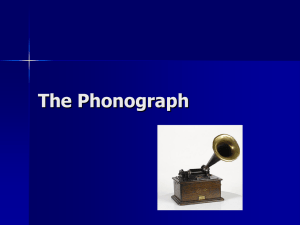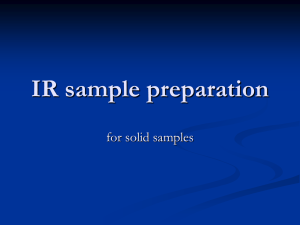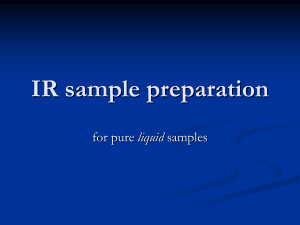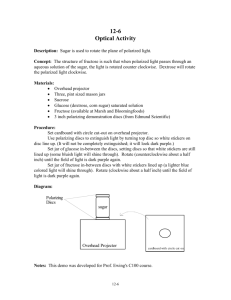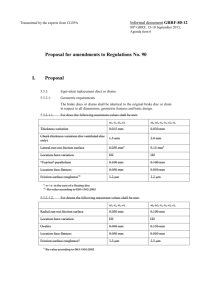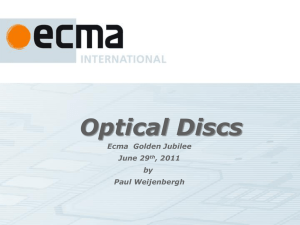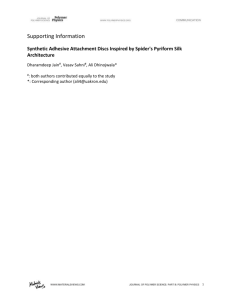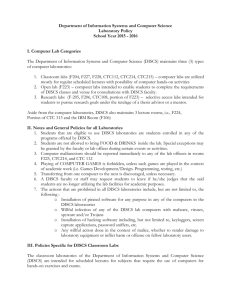Optical Media
advertisement
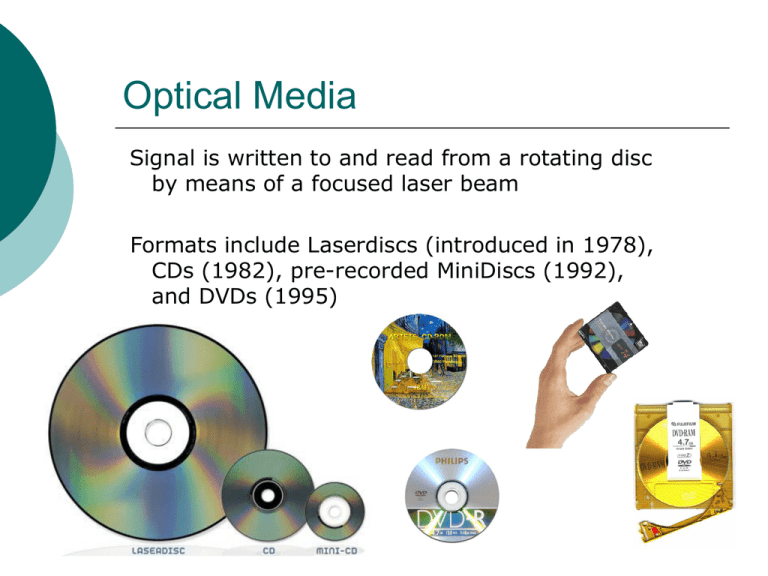
Optical Media Signal is written to and read from a rotating disc by means of a focused laser beam Formats include Laserdiscs (introduced in 1978), CDs (1982), pre-recorded MiniDiscs (1992), and DVDs (1995) Optical Media — CDs and DVDs Numerous format variants: CD-ROM, CD-R, CD-RW, DVDROM, DVD-R, DVD-RW, DVD-RAM, Blu-Ray DVD, and many more Standard size is 12cm (4.75”) in diameter and 1.2mm thick, but structurally there is wide variation Complex laminate structures vulnerable to damage from light, temperature, humidity, and poor handling Recordable media (e.g., CD-Rs and DVD-Rs) are the variants most likely to be found in Special Collections, and are also the most vulnerable Optical Media — Structure All optical discs have: Substrate (base layer) Metal reflective layer Polycarbonate (hygroscopic) aluminum, silver, silver alloy, or gold Data layer Molded, photosensitive dye, or phase-changing metal alloy Some discs have: Protective lacquer coating on top and sides (CDs) Adhesive layer (DVDs) Label or printable surface ALL of these components are vulnerable to multiple types of damage and deterioration Three Types of CDs and DVDs Read-Only/Replicated (ROM discs) Recordable/Write-Once (R discs) Data layer is molded into the base layer surface Data layer is a photosensitive organic dye (phthalocyanine, cyanine, or azo) Rewritable/Erasable (RW discs) Data layer is a phase-changing metal alloy film Disc Structure: CD vs. DVD Damage and Deterioration (1) Oxidation or corrosion of metal reflective layer Dye fading Causes: exposure to light and/or heat, natural aging, repeated playback Recorded areas become less distinguishable from unrecorded areas Base layer damage or degradation Causes: incursion of oxygen or moisture via scratches or other surface damage Diminishes reflectivity, making disc unreadable Appears as pin holes when disc is held up to the light and/or brownish discoloration Causes: poor handling, solvents (crazing), natural aging, darkening caused by light Loss of base transparency leads to read errors or tracking problems Lacquer layer damage or degradation Causes: scratches, solvents, natural aging, label adhesives and inks, fingerprints Can expose or damage the vulnerable metal reflective layer Damage and Deterioration (2) Deformation (delamination, shrinkage, warping, cracking) Causes: Heat, temperature and RH fluctuations, mishandling, physical stress (flexing, bending, etc.), horizontal storage, removal or expansion/contraction of adhesive labels Deformed discs cannot spin properly, and can even damage playback equipment Care and Handling Avoid touching disc surfaces Hold discs by gently grasping the outer edges or or placing a finger in the center hole Never bend or flex discs Remove a disc from its container by pressing down on the center hub to release Never leave a disc sitting inside playback equipment Clean discs with a soft, non-abrasive, lint-free cloth; use distilled water only if absolutely necessary Wipe discs radially (from center to outer edge) Inspect discs periodically for signs of deterioration Labelling Do not apply adhesive labels to disc surfaces (labels can warp or unbalance discs, inks may damage lacquer) Do not attempt to peel off adhesive labels (this may delaminate the disc) If you must write on an optical disc, write only on the clear inner hub on the label side of the disc Never write on discs with a writing implement that could scratch the disc (possibly damaging the data below) or that uses ink containing acids that could damage the lacquer protective layer AIC Electronic Media Group’s Optical Media pen http://aic.stanford.edu/sg/emg (felt tip, water-soluble ink) Environment and Storage Store in a clean, cool, dry, dark environment Minimize exposure to light, heat, and humidity Avoid dramatic changes in temperature or RH Orient discs vertically in rigid enclosures specifically designed for optical media; never stack discs horizontally or allow them to lean Do not pack discs too tightly or loosely on shelves Return discs to storage containers immediately after use to avoid surface damage and exposure to light Preferred Containers Rigid, impact-resistant containers made inert materials (PVC jewel cases may emit corrosive gases) of Locking mechanism to prevent accidental opening Good hub (preferably a self-releasing one that prevents the disc from touching the container) Avoid paper or plastic sleeves, thin jewel cases, and other flexible containers (which provide little physical protection, may interact chemically with the disc, and can scratch disc surfaces) If possible, remove liner notes or other materials from the container (paper attracts moisture and creates dust) Requires Immediate Attention Visually discernable evidence of damage or deterioration such as delamination, oxidation or other discoloration, chips, or gouges Early date of manufacture: Pre-1995 for CD-Rs, Pre-1999 for DVD-Rs Please Contact Us Weissman Preservation Center 617-495-8596 http://preserve.harvard.edu Jane Hedberg jane_hedberg@harvard.edu Elizabeth Walters elizabeth_walters@harvard.edu Liz Coffey coffey@fas.harvard.edu
